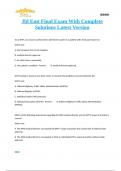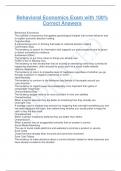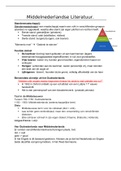Chapter 1. Heat Equation
Section 1.2
1.2.9 (d) Circular cross section means that P = 2πr, A = πr2 , and thus P/A = 2/r, where r is the radius.
Also γ = 0.
1.2.9 (e) u(x, t) = u(t) implies that
du 2h
cρ =− u.
dt r
The solution of this first-order linear differential equation with constant coefficients, which satisfies the
initial condition u(0) = u0 , is · ¸
2h
u(t) = u0 exp − t .
cρr
Section 1.3
R
1.3.2 ∂u/∂x is continuous if K0 (x0 −) = K0 (x0 +), that is, if the conductivity is continuous.
U
Section 1.4
1.4.1 (a) Equilibrium satisfies (1.4.14), d2 u/dx2 = 0, whose general solution is (1.4.17), u = c1 + c2 x. The
SE
boundary condition u(0) = 0 implies c1 = 0 and u(L) = T implies c2 = T /L so that u = T x/L.
1.4.1 (d) Equilibrium satisfies (1.4.14), d2 u/dx2 = 0, whose general solution (1.4.17), u = c1 + c2 x. From
the boundary conditions, u(0) = T yields T = c1 and du/dx(L) = α yields α = c2 . Thus u = T + αx.
IS
1.4.1 (f) In equilibrium, (1.2.9) becomes d2 u/dx2 = −Q/K0 = −x2 , whose general solution (by integrating
twice) is u = −x4 /12 + c1 + c2 x. The boundary condition u(0) = T yields c1 = T , while du/dx(L) = 0
yields c2 = L3 /3. Thus u = −x4 /12 + L3 x/3 + T .
O
1.4.1 (h) Equilibrium satisfies d2 u/dx2 = 0. One integration yields du/dx = c2 , the second integration
yields the general solution u = c1 + c2 x.
N
x=0: c2 − (c1 − T ) = 0
x=L: c2 = α and thus c1 = T + α.
N
Therefore, u = (T + α) + αx = T + α(x + 1).
O
1.4.7 (a) For equilibrium:
d2 u x2 du
= −1 implies u = − + c1 x + c2 and = −x + c1 .
C
dx 2 2 dx
From the boundary conditions du du
dx (0) = 1 and dx (L) = β, c1 = 1 and −L + c1 = β which is consistent
ED
2
only if β + L = 1. If β = 1 − L, there is an equilibrium solution (u = − x2 + x + c2 ). If β 6= 1 − L,
there isn’t an equilibrium solution. The difficulty is caused by the heat flow being specified at both
ends and a source specified inside. An equilibrium will exist only if these three are in balance. This
balance can be mathematically verified from conservation of energy:
M
Z Z L
d L du du
cρu dx = − (0) + (L) + Q0 dx = −1 + β + L.
dt 0 dx dx 0
If β + L = 1, then the total thermal energy is constant and the initial energy = the final energy:
Z L Z Lµ 2 ¶
x
f (x) dx = − + x + c2 dx, which determines c2 .
0 0 2
If β + L 6= 1, then the total thermal energy is always changing in time and an equilibrium is never
reached.
1
, Section 1.5
d
¡ du ¢
1.5.9 (a) In equilibrium, (1.5.14) using (1.5.19) becomes dr r dr = 0. Integrating once yields rdu/dr = c1
and integrating a second time (after dividing by r) yields u = c1 ln r + c2 . An alternate general solution
is u = c1 ln(r/r1 ) + c3 . The boundary condition u(r1 ) = T1 yields c3 = T1 , while u(r2 ) = T2 yields
c1 = (T2 − T1 )/ ln(r2 /r1 ). Thus, u = ln(r21/r1 ) [(T2 − T1 ) ln r/r1 + T1 ln(r2 /r1 )].
1.5.11 For equilibrium, the radial flow at r = a, 2πaβ, must equal the radial flow at r = b, 2πb. Thus β = b/a.
d
¡ 2 du ¢
1.5.13 From exercise 1.5.12, in equilibrium dr r dr = 0. Integrating once yields r2 du/dr = c1 and integrat-
2
ing a second time (after dividing by r ) yields u = −c1 /r + c2 . The boundary conditions ¡ u(4) ¢ = 80
and u(1) = 0 yields 80 = −c1 /4 + c2 and 0 = −c1 + c2 . Thus c1 = c2 = 320/3 or u = 320 3 1 − 1r .
R
U
SE
IS
O
N
N
O
C
ED
M
2
,Chapter 2. Method of Separation of Variables
Section 2.3
³ ´ ³ ´
dφ
2.3.1 (a) u(r, t) = φ(r)h(t) yields φ dh = kh d
r dr . Dividing by kφh yields
1 dh
= 1 d
r dφ = −λ or
³ ´ dt r dr kh dt rφ dr dr
dh 1 d dφ
dt = −λkh and r dr r dr = −λφ.
2 2 2 2
2.3.1 (c) u(x, y) = φ(x)h(y) yields h ddxφ2 + φ ddyh2 = 0. Dividing by φh yields 1 d φ
φ dx2 = − h1 ddyh2 = −λ or
d2 φ d2 h
dx2 = −λφ and dy 2 = λh.
4 4
d φ 1 d φ
2.3.1 (e) u(x, t) = φ(x)h(t) yields φ(x) dh
dt = kh(t) dx4 . Dividing by kφh, yields
1 dh
kh dt = φ dx4 = λ.
2 2 2
1 d2 h
2.3.1 (f) u(x, t) = φ(x)h(t) yields φ(x) ddt2h = c2 h(t) ddxφ2 . Dividing by c2 φh, yields c2 h dt2 = 1 d φ
φ dx2 = −λ.
2.3.2 (b) λ = (nπ/L)2 with L = 1 so that λ = n2 π 2 , n = 1, 2, . . .
R
2.3.2 (d)
√ √ dφ
(i) If λ > 0, φ = c1 cos λx + c2 sin λx. φ(0) = 0 implies c1 = 0, while dx (L) = 0 implies
U
√ √ √
c2 λ cos λL = 0. Thus λL = −π/2 + nπ(n = 1, 2, . . .).
SE
(ii) If λ = 0, φ = c1 + c2 x. φ(0) = 0 implies c1 = 0 and dφ/dx(L) = 0 implies c2 = 0. Therefore λ = 0
is not an eigenvalue.
√ √
(iii) If λ < 0, let
√ λ = −s√ and φ = c1 cosh sx + c2 sinh sx. φ(0) = 0 implies c1 = 0 and dφ/dx(L) = 0
implies c2 s cosh sL = 0. Thus c2 = 0 and hence there are no eigenvalues with λ < 0.
IS
2.3.2 (f) The simpliest method is to let x0 = x − a. Then d2 φ/dx02 + λφ = 0 with φ(0) = 0 and φ(b − a) = 0.
2
Thus (from p. 46) L = b − a and λ = [nπ/(b − a)] , n = 1, 2, . . ..
P∞
O
−k(nπ/L)2 t
2.3.3 From (2.3.30), u(x, t) = n=1 Bn sin nπxL e . The initial condition yields
P∞ 2 L
R
nπx
2 cos L = n=1 Bn sin L . From (2.3.35), Bn = L 0 2 cos 3πx
3πx nπx
L sin L dx.
N
RL P∞ 2
Bn e−k( )
nπ
t 1−cos nπ
2.3.4 (a) Total heat energy = 0
cρuA dx = cρA n=1
L
nπ , using (2.3.30) where Bn
L
N
satisfies (2.3.35).
2.3.4 (b)
O
heat flux to right = −K0 ∂u/∂x
total heat flow to right = −K0 A∂u/∂x
¯
heat flow out at x = 0 = K0 A ∂u ¯
C
¯
∂x x=0
∂u ¯
heat flow out (x = L) = −K0 A ∂x x=L
¯L
ED
d
RL ¯
2.3.4 (c) From conservation of thermal energy, dt 0
u dx = k ∂u ∂u ∂u
∂x ¯ = k ∂x (L) − k ∂x (0). Integrating from
0
t = 0 yields
Z L Z L Z t· ¸
∂u ∂u
u(x, t) dx − u(x, 0) dx = k (L) − (0) dx .
∂x ∂x
M
|0 {z } |0 {z } | 0 {z } | {z }
heat energy initial heat integral of integral of
at t energy flow in at flow out at
x=L x=L
2 p p
2.3.8 (a) The general solution of k ddxu2 = αu (α > 0) is u(x) = a cosh αk x + b sinh αk x. The boundary
condition u(0) = 0 yields a = 0, while u(L) = 0 yields b = 0. Thus u = 0.
3
, 2
d φ
2.3.8 (b) Separation of variables, u = φ(x)h(t) or φ dh
dt + αφh = kh dx2 , yields two ordinary differential
2
1 dh α 1 d φ
equations (divide by kφh): kh dt + k = φ dx2 = −λ. Applying the boundary conditions, yields the
eigenvalues λ = (nπ/L)2 and corresponding eigenfunctions φ = sin nπx L . The time-dependent part are
−λkt −αt −αt
P ∞ nπx −k(nπ/L)2 t
exponentials, h = e e . Thus by superposition, u(x, t) = e n=1 bn sin L e , where
P∞ R
2 L
the initial conditions u(x, 0) = f (x) = n=1 bn sin nπx
L yields b n = L 0 f (x) sin nπx
L dx. As t → ∞,
u → 0, the only equilibrium solution.
q q
2.3.9 (a) If α < 0, the general equilibrium solution is u(x) = a cos −α k x + b sin −α
x. The boundary
q qk
condition u(0) = 0 yields a = 0, while u(L) = 0 yields b sin −α k L = 0. Thus if
−α
k L 6= nπ, u = 0 is
q
the only equilibrium solution. However, if −α nπx
k L = nπ, then u = A sin L is an equilibrium solution.
¡ π ¢2
2.3.9 (b) Solution obtained in 2.3.8 is correct. If − αk = L , u(x, t) → b1 sin πx
L , the equilibrium solution.
α
¡ π
¢2 α
¡ π ¢2
If − k < L , then u → 0 as t → ∞. However, if − k > L , u → ∞ (if b1 6= 0). Note that b1 > 0 if
f (x) ≥ 0. Other more unusual events can occur if b1 = 0. [Essentially, the other possible equilibrium
R
solutions are unstable.]
U
Section 2.4
2.4.1 The solution is given by (2.4.19), where the coefficients satisfy (2.4.21) and hence (2.4.23-24).
SE
RL RL ¯
nπx ¯L
(a) A0 = L1 L/2 1dx = 21 , An = L2 L/2 cos nπx
L dx = 2
·
L nπ
L
sin 2 nπ
L ¯L/2 = − nπ sin 2
(b) by inspection A0 = 6, A3 = 4, others = 0.
RL ¯L RL
πx ¯
(c) A0 = −2
L 0 sin πx
L dx = 2
π cos 2
IS
L ¯ = π (1 − cos π) = 4/π, An =
0
−4
L 0
sin πx nπx
L cos L dx
(d) by inspection A8 = −3, others = 0.
O
2.4.3 Let x0 = x − π. Then the boundary value problem becomes d2 φ/dx02 = −λφ subject to φ(−π) = φ(π)
and dφ/dx0 (−π) = dφ/dx0 (π). Thus, the eigenvalues are λ = (nπ/L)2 = n2 π 2 , since L = π, n =
0, 1, 2, ... with the corresponding eigenfunctions being both sin nπx0 /L = sin n(x−π) = (−1)n sin nx =>
N
sin nx and cos nπx0 /L = cos n(x − π) = (−1)n cos nx => cos nx.
N
Section 2.5
2
O
2
2.5.1 (a) Separation of variables, u(x, y) = h(x)φ(y), implies that h1 ddxh2 = − φ1 ddyφ2 = −λ. Thus d2 h/dx2 =
−λh subject to h0 (0) = 0 and h0 (L) = 0. Thus as before, λ = (nπ/L)2 , n = 0, l, 2, . . . with h(x) =
2 ¡ ¢2
cos nπx/L. Furthermore, ddyφ2 = λφ = nπ
C
L φ so that
n = 0 : φ = c1 + c2 y, where φ(0) = 0 yields c1 = 0
ED
n 6= 0 : φ = c1 cosh nπy nπy
L + c2 sinh L , where φ(0) = 0 yields c1 = 0.
The result of superposition is
∞
X nπx nπy
u(x, y) = A0 y + An cos sinh .
M
n=1
L L
The nonhomogeneous boundary condition yields
∞
X nπH nπx
f (x) = A0 H + An sinh cos ,
n=1
L L
so that Z Z
L L
1 nπH 2 nπx
A0 H = f (x) dx and An sinh = f (x) cos dx.
L 0 L L 0 L
4







